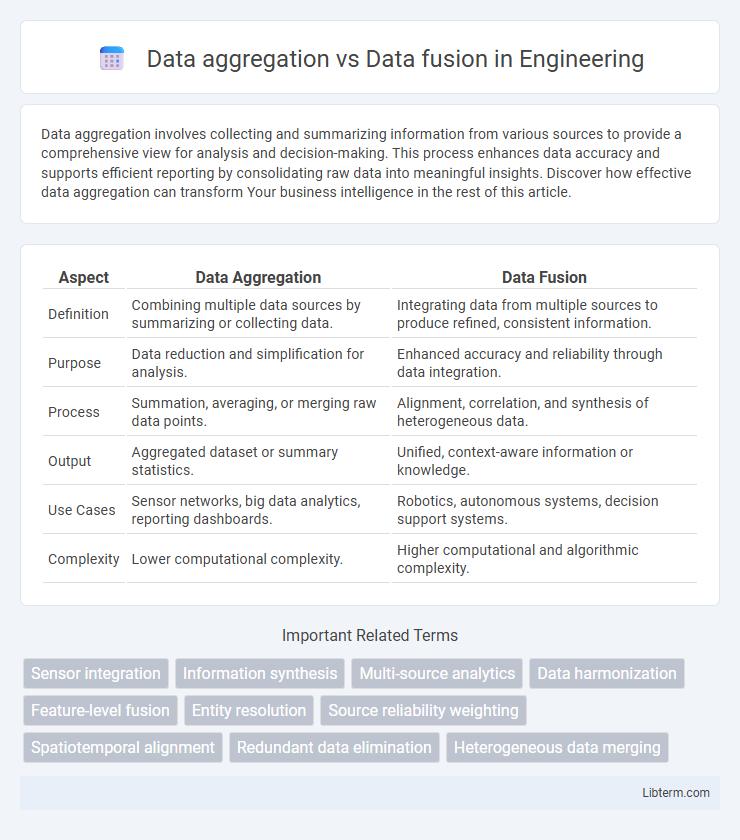Data aggregation involves collecting and summarizing information from various sources to provide a comprehensive view for analysis and decision-making. This process enhances data accuracy and supports efficient reporting by consolidating raw data into meaningful insights. Discover how effective data aggregation can transform Your business intelligence in the rest of this article.
Table of Comparison
| Aspect | Data Aggregation | Data Fusion |
|---|---|---|
| Definition | Combining multiple data sources by summarizing or collecting data. | Integrating data from multiple sources to produce refined, consistent information. |
| Purpose | Data reduction and simplification for analysis. | Enhanced accuracy and reliability through data integration. |
| Process | Summation, averaging, or merging raw data points. | Alignment, correlation, and synthesis of heterogeneous data. |
| Output | Aggregated dataset or summary statistics. | Unified, context-aware information or knowledge. |
| Use Cases | Sensor networks, big data analytics, reporting dashboards. | Robotics, autonomous systems, decision support systems. |
| Complexity | Lower computational complexity. | Higher computational and algorithmic complexity. |
Introduction to Data Aggregation and Data Fusion
Data aggregation involves collecting and summarizing raw data from multiple sources into a coherent dataset for easier analysis, often used in databases and sensor networks. Data fusion, on the other hand, combines data from various sensors or sources to produce more consistent, accurate, and useful information than that provided by any individual source. Both processes enhance decision-making but differ in complexity, with data fusion emphasizing integration and interpretation for improved insights.
Defining Data Aggregation: Key Concepts
Data aggregation involves the systematic collection and summarization of data from multiple sources to produce a consolidated dataset, emphasizing volume reduction and efficiency in data handling. Key concepts include data summarization, where raw data is transformed into meaningful aggregates such as sums, averages, or counts, and data integration that combines heterogeneous data formats into a uniform representation. Unlike data fusion, which aims to create new, enhanced information by combining data at a deeper semantic level, data aggregation primarily focuses on simplifying and compressing information for analysis or reporting purposes.
Understanding Data Fusion: An Overview
Data fusion integrates data from multiple heterogeneous sources to produce more consistent, accurate, and useful information than individual datasets alone. Unlike data aggregation, which simply combines raw data, data fusion applies advanced algorithms to synthesize information, resolve conflicts, and enhance data quality for decision-making. This process is essential in domains like sensor networks, robotics, and intelligence analysis, where comprehensive situational awareness depends on multidimensional data integration.
Core Differences Between Data Aggregation and Data Fusion
Data aggregation involves collecting and summarizing raw data from multiple sources to create a concise dataset, emphasizing volume reduction and simplification. Data fusion integrates data from diverse sources to produce new, more accurate information by enhancing context and resolving conflicts between datasets. Core differences lie in aggregation's focus on data consolidation and reduction, while fusion targets information enrichment and improved decision-making accuracy.
Use Cases for Data Aggregation
Data aggregation consolidates large volumes of data from multiple sources into a unified dataset, enabling efficient analysis in applications like business intelligence, customer analytics, and financial reporting. It is particularly valuable in healthcare for compiling patient records from various departments to improve treatment plans and operational efficiency. Use cases also extend to IoT networks, where aggregated sensor data supports environmental monitoring and predictive maintenance.
Applications of Data Fusion Across Industries
Data fusion integrates multisource data to enhance decision-making accuracy and operational efficiency across industries such as healthcare, defense, and smart cities. In healthcare, it combines patient records, imaging, and sensor data for improved diagnostics and personalized treatment. Defense applications utilize data fusion for real-time situational awareness, integrating radar, satellite, and communication systems to support tactical operations.
Benefits and Limitations of Data Aggregation
Data aggregation simplifies the analysis process by collecting and summarizing large datasets into concise forms, enhancing decision-making efficiency in fields like business intelligence and sensor networks. Benefits include reduced data volume, faster processing, and improved clarity, but limitations involve potential loss of detail and accuracy, which can obscure critical insights or nuances within the original data. In contrast, data fusion integrates information from multiple sources to create a more comprehensive dataset, offering richer context but requiring complex algorithms and higher computational resources.
Advantages and Challenges of Data Fusion
Data fusion integrates data from multiple heterogeneous sources to provide more accurate, consistent, and useful information than simple data aggregation, enhancing decision-making and situational awareness. Its advantages include improved data quality through redundancy elimination and noise reduction, increased reliability from diverse sensor inputs, and the ability to generate new insights by combining different data types. Challenges involve handling data heterogeneity, synchronization issues, computational complexity, and ensuring real-time processing capabilities in dynamic environments.
Choosing Between Data Aggregation and Data Fusion
Choosing between data aggregation and data fusion depends on the specific goals of data integration and analysis. Data aggregation combines multiple data points to provide summarized insights, suitable for reducing data volume and identifying trends, while data fusion integrates data from diverse sources to create a more comprehensive and accurate representation. Selecting the appropriate approach requires evaluating the need for either simplified data consolidation or enriched, multidimensional understanding.
Future Trends in Data Aggregation and Data Fusion
Future trends in data aggregation include the integration of real-time streaming analytics and the expansion of AI-driven automation to enhance data accuracy and scalability. In data fusion, advancements in deep learning and edge computing are expected to improve the synthesis of heterogeneous data sources, enabling more precise and context-aware insights. Both technologies will increasingly leverage IoT and 5G networks to support faster, larger-scale data processing for applications in smart cities and autonomous systems.
Data aggregation Infographic

 libterm.com
libterm.com